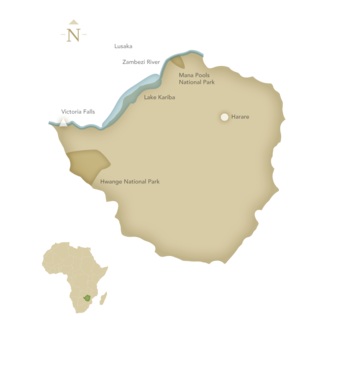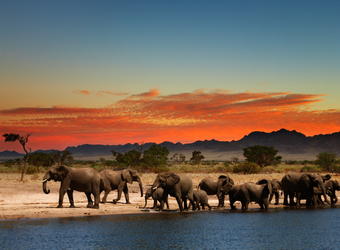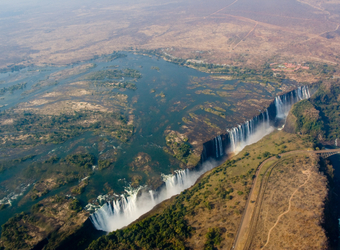Zimbabwe
| Read Reviews | Write a Review Start Planning Your Custom Safari
 view larger image
view larger image
Though Zimbabwe often grabs headlines for its troubled economy and government, such a focus masks the country’s enduring treasures: its magnificent wilderness and lovely people. On safari in Zimbabwe’s lightly visited national parks, touch the African wilds as they were 150 years ago—a vast, raw landscape of powerful rivers, floodplains and rocky escarpments brimming with animals, including huge herds of elephant, rare wild dog and black rhinoceros. Enjoy exceptional hospitality at top camps and lodges. And marvel at Victoria Falls, the largest curtain of falling water in the world.
Read About the Different Regions and Parks in Zimbabwe

Our Expert Says
For the past dozen years folks have spoken of Zimbabwe in cautious terms, but there is so, so much to love about this diverse country. Game camps are rich with wildlife, diverse activities include canoeing and walking safaris, and the vast open spaces make safari experiences in Zimbabwe remarkably personal. Awakening early for my first day on safari, we stopped at a waterhole in Hwange National Park—there in the cool morning air, as I poured myself a hot coffee, a herd of 150 elephants approached from behind the trees, silhouetted in the rising sun! An endless parade of wildlife continued for the next two weeks, creating one serious Zimbabwe fan!
– Ben Bressler
 view image gallery
view image gallery
Zimbabwe Safari Highlights
Zimbabwe’s national parks and private reserves offer some of Africa’s most superlative wildlife viewing. Animals congregate in great numbers in the Hwange region and along the Zambezi River in Mana Pools, with concentrations most intense during the dry season. Zimbabwe boasts some of the best guides in Africa, many who are seasoned leaders of walking safaris that offer remarkably intimate encounters with the natural environs. Day and night game drives and canoe safaris on the Zambezi are also thrilling ways to see Zimbabwe’s tremendous diversity of wildlife, including the legendary Big Five: elephant, Cape buffalo, lion, leopard and rhinoceros. Toast your safari exploits with sundowners at river's edge as the sun sinks over the mountains in adjacent Zambia. Of course no Zimbabwe safari would be complete without a visit to Victoria Falls, one of the most amazing natural wonders on the planet.
 view image gallery
view image gallery
Zimbabwe Wildlife
From huge herds of elephants in Hwange to the hippo-filled lagoons of Mana Pools, Zimbabwe’s parks teem with wildlife. The Mana Pools section of the Zambezi Valley is true wilderness, with one of the highest dry-season concentrations of animals in Africa. On these wide floodplains you’ll find enormous elephants and big, burly buffalo, great rafts of Nile crocodile, a few black rhino, and plenty of predators including lion, leopard, cheetah and jackal. Among the 380 bird species in the park are the Nyasa lovebird, Livingstone’s flycatcher, banded snake eagle, yellow-billed kites and huge numbers of carmine bee eaters that burrow nests into the sandy riverbanks. Hwange National Park is also home to grazing herds of zebra and giraffe. Among the park’s 105 mammal species are endangered gemsbok and brown hyena as well as one of Africa's largest surviving groups of African wild dog.
 view image gallery
view image gallery
Quick Zimbabwe Facts
Slightly larger than Montana at 150,000 square miles, Zimbabwe is bordered by Mozambique, South Africa, Botswana and Zambia. The east is mostly high plateau and mountains containing rich mineral resources, especially coal, metallic ores and diamonds. The Zambezi River forms a natural boundary with Zambia on the west. Formerly known as Rhodesia, Zimbabwe gained independence from the United Kingdom in 1980. President Robert Mugabe has been the country’s only leader since. His disastrous land redistribution campaign begun in 2000 seized commercially productive agricultural land, eradicating jobs, crippling the economy and causing widespread shortages of basic commodities for Zimbabwe’s 12 million people. Despite a decade of catastrophe, Zimbabwe’s economy is growing again, offering a glimmer of hope for its impoverished population, 82% of which are ethnic Shona.
 view image gallery
view image gallery
Conservation in Zimbabwe
More than 20% of Zimbabwe is set aside as national parks and game reserves. Yet the country struggles with many environmental problems that negatively impact wildlife: deforestation, soil erosion and air and water pollution, including toxic mine waste. Its black rhinoceros herd—once the largest in the world—has been severely reduced by poaching, though numbers are rising again thanks to conservation groups such as WWF that are engaged in protecting miombo woodland habitat and supporting intensive anti-poaching measures. Though many NGOs left amid political strife, some, like the Zimbabwe Conservation Task Force, continue to fight for wildlife adversely impacted by Mugabe’s land grab. While widespread poverty has led to rampant poaching and illegal resource use, incremental progress is being made toward recovering the important place of wildlife tourism in Zimbabwe's economy.
